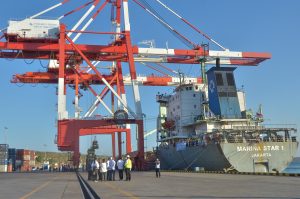Indonesian policymakers are considering relocating import entry ports for seven commodities – textiles, garments, ceramics, footwear, apparel, cosmetics, and electronics – to eastern ports in Sorong West Papua, Bitung North Sulawesi, and Tenau Kupang East Nusa Tenggara. The relocation is planned after the relaxation of import licensing on the seven commodities under Trade Minister Regulation 48/2024, which, among others, waives technical considerations as a requirement for obtaining import license.
If implemented, the relocation would be a policy shortcut to reduce imports and help domestic industries compete. Shifting imports to more distant ports increases logistics costs and retail prices, thereby giving local products a competitive price edge. However, it potentially violates multilateral rules under the General Agreement on Tariffs and Trade (GATT) 1994.
Currently, 75 percent of Indonesia’s non-oil and gas imports are handled in Java Island in the western part of the country, through the major ports of Tanjung Priok (Jakarta), Tanjung Emas (Semarang, Central Java), and Tanjung Perak (Surabaya, East Java). Java, home to 156.9 million people – 55 percent of Indonesia’s population – hosts the majority of consumers and distribution centers for imported goods. The remaining 45 percent is spread across other islands in the western, central, and eastern regions.
As it stands, Tanjung Priok is the largest port for importing the seven commodities in question. For example, in 2023, the port handled footwear imports worth $616.4 million, or 64 percent of the country’s total footwear imports of $968.8 million.
In contrast, import activities in West Papua, North Sulawesi, and East Nusa Tenggara are trivial, accounting for 0.02 percent, 0.05 percent, and 0.02 percent of Indonesian imports, respectively. Sorong, Bitung, and Tenau Kupang ports do not handle any imports of the seven commodities flagged in the new policy.
Importers will bear higher costs if they must transport goods from the countries of origin to ports in the east and then to Java. The sea distance from Sorong to Jakarta, for instance, is 3,935 kilometers, and vessels transit through Makassar in Sulawesi and Surabaya. The relocation of entry ports thus creates a barrier for imports and will boost the price competitiveness of local products.
Indeed, imports of seven commodities have surged and are drowning local industries. The most disruptive imports are goods sold at below-normal prices from China, while imported goods from other countries are generally traded at standard market prices.
Moreover, illegal imports have been out of control, worsening the injuries suffered by local industries. Back in October 2015, President Joko Widodo declared that he had ordered the customs service to investigate illegal imports. He announced that the order had been properly executed, and illegal import activities had been curbed.
Yet nine years later, in July 2024, an inter-ministerial and agency task force was established to address the widespread cheap and illegal imported goods. The task force has flexed its muscles by closing warehouses, confiscating and destroying these illegal goods.
Now Indonesia is considering a new approach. The relocation of entry ports would have the effect of raising prices and reducing the supply of goods from all countries, giving a leg up to local manufacturers. The change would, however, also limit consumer choices and force them to buy local products that may not always match their preferences.
Port relocation is a trade measure, and thus its conformity with multilateral rules should be considered. GATT 1994 Article XI:1 (General Elimination of Quantitative Restrictions) prohibits “prohibitions or restrictions other than duties, taxes or other charges, whether made effective through quotas, import or export licences or other measures.” Panels in relevant World Trade Organization dispute settlements have interpreted “other measures” to include a “broad residual category” affecting the competitiveness of goods.
The forced port relocation implies restriction on the number of ports available for imports. The Colombia-Panama case in the WTO dispute settlement mechanism (DS366) during 2007-2009 serves as a reference for determining whether such a measure constitutes an import restriction.
In that case, Colombia prohibited imports of textiles, footwear, and apparel from Panama or the Colon Free Zone (CFZ), except for imports sent to Bogota airport and Barranquilla seaport. Panama argued that the port restriction imposed a limiting condition because there were only two ports of entry, out of 11 total, available. Panama said it limited competition by forcing importers to incur higher shipping costs to reach key markets outside Bogota and Barranquilla, discouraging exports and creating uncertainty, making the restriction in violation of GATT Article XI:1.
On May 20, 2009, the WTO Dispute Settlement Body adopted the panel’s report, which inter alia judged that Colombia’s port restriction was a prohibited restriction on importation. The port restriction, though not a quota or import license, could be considered one of the “other measures” outlawed by Article XI:1.
Although Colombia’s port prohibition was applied discriminatively to imports only from Panama or the CFZ, the panel judged that the measure, whether discriminatory or not, breached Article XI:1. This could set a precedent if Indonesia adopts port restrictions, even if not aimed at a particular country, and the measure is challenged at the WTO.
Indonesian policymakers need to cautiously weigh the economic benefits of supporting local industries against the costs of limiting consumer choices and the risks of non-compliance with multilateral trade rules.

































